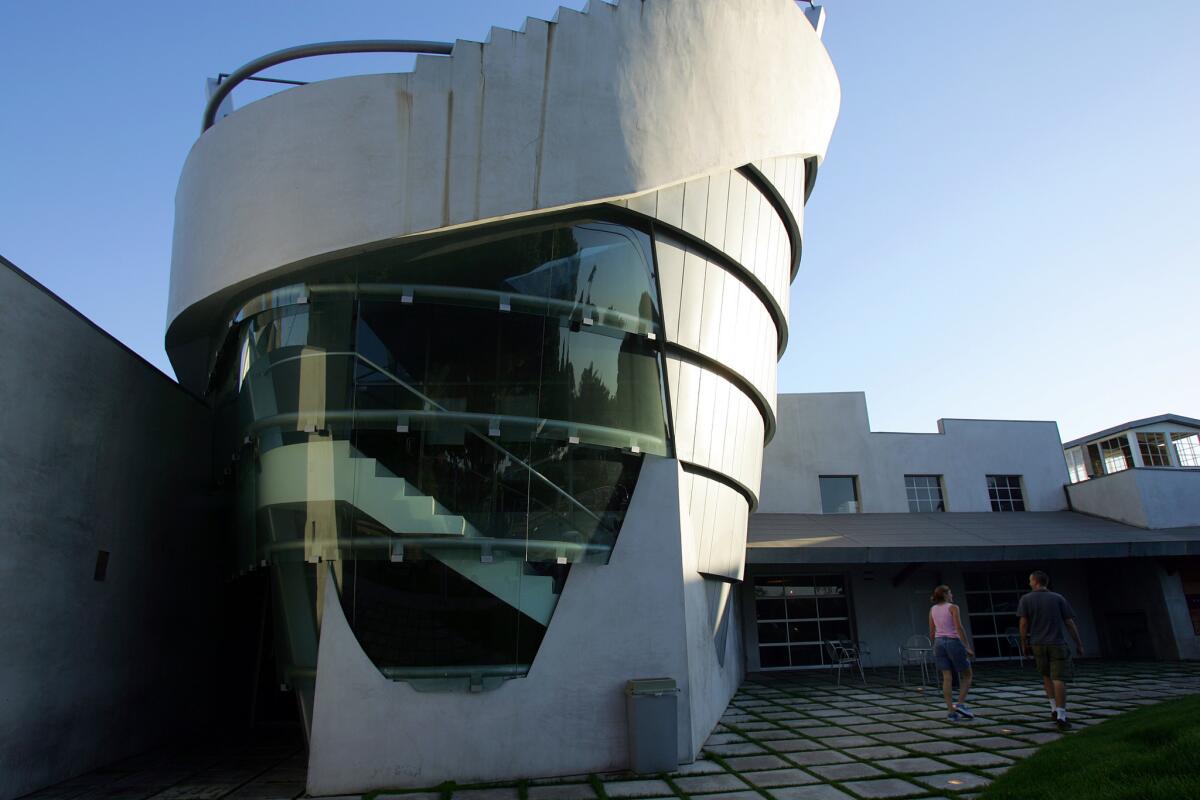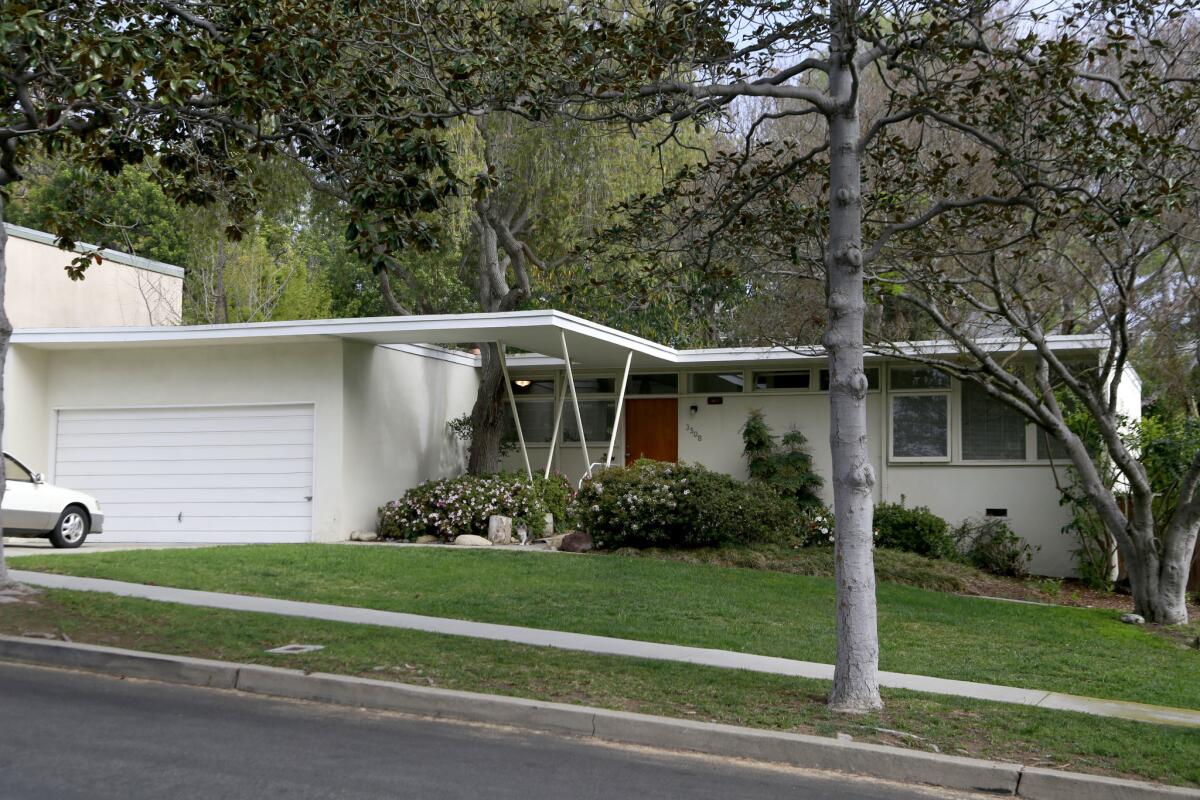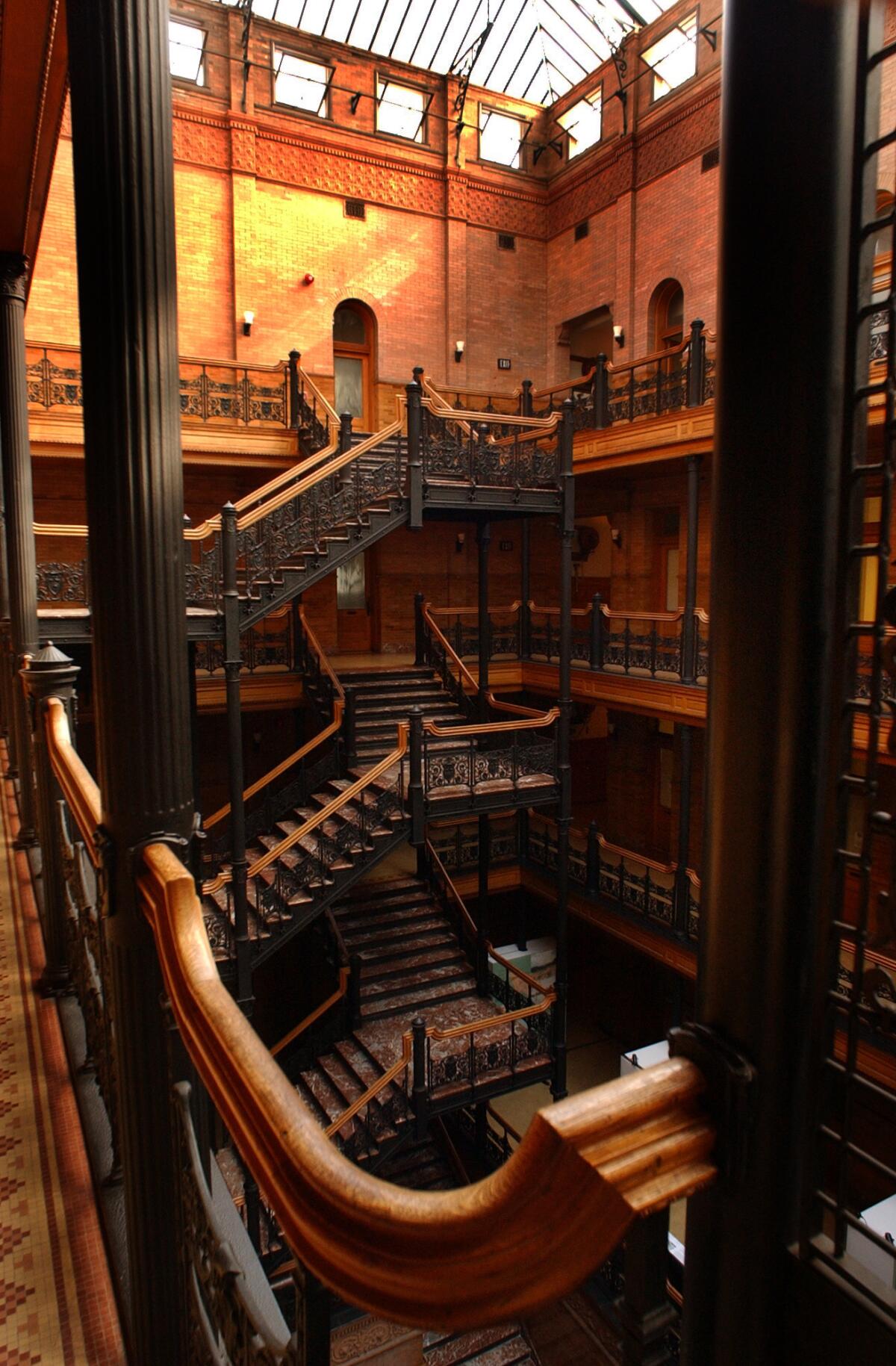The revised ‘Bible’ of L.A. architecture is out. Let it be your guide

We think of Los Angeles as a city of sprawl, but it is just as much a city of neighborhoods.
Here’s an example of what I mean. A couple of years ago, I spent a day riding Metro Rail in its entirety: every station and mile of track. Expo Line to the Blue Line to the Green Line; Red Line, Purple Line and Gold. The idea was to see how limited the system must be if it could be traversed in such a narrow span of time, but the effect, it turned out, was the opposite. Starting in mid-Wilshire, I found myself passing through the South Bay, Long Beach, downtown, North Hollywood, East Los Angeles. I ranged as far east as Azusa, then west again to Santa Monica.
As I traveled, I took note of landmarks: the Watts Towers, the Highland Theatre, LAX. The experience was like moving through a map in real time, in which Los Angeles revealed itself as small and large. By the time I was done, I was aware of a curious double vision, a sense of the pieces that make up the city and also the shape of the broader metropolis. It is this sort of cognitive dissonance — or negative capability — that, I want to tell you, Los Angeles requires of us.

A similar sensibility informs David Gebhard and Robert Winter’s “An Architectural Guidebook to Los Angeles,” which offers a complicated, and at times contradictory, engagement with the city not unlike what I discovered on the train. Originally published in 1965 by the Los Angeles County Museum of Art, it has just been reissued in a sixth edition that is significantly revised.
“Many professionals simply call it The Bible,” Nathan Masters notes in a foreword that traces the book’s history. Developed for the 1964 annual meeting of the Society of Architectural Historians — the authors, in what may be my favorite detail, missed their deadline — it was revised in 1977, 1985 and 1994, and again in 2003, despite Gebhard’s death in 1996.
That last edition was Winter’s alone; “I am proud of it,” he acknowledges, “even though I realize that it would have been better if I had had another person’s cooperation.” This time out, Winter, who is 94 and largely homebound, has enlisted Robert Inman, his former student and author of two books about the city’s urban stairways, to collaborate. What they’ve done is essentially to reinvent the “Guidebook,” reworking its organization and adding 700 structures while removing 500 others, including 150 or so that, Inman writes, “we deemed weak.”
I love this aspect of the project because it reveals, as it must, the inherent subjectivity of even the most authoritative look at a city that defies as it invigorates. “They would always ask, ‘Is it in the Guide?’” Winter remembers, referring to the 12 years he spent on the Los Angeles Cultural Heritage Board. “I told them, ‘It’s by two guys; it’s their personal feelings. That’s all.’”
That subjectivity is one of the best things about “An Architectural Guidebook to Los Angeles,” because this is a book that encourages us to argue with it. For this new version, Winter and Inman have done away with the back-and-forth movement of earlier editions (the 2003 “Guidebook” started in Malibu and swept through Beverly Hills and Hollywood to downtown and Downey before shifting abruptly to Pasadena, Claremont and Diamond Bar), choosing instead to frame the city in more traditional terms.

This means beginning with downtown — “Heart of the City,” they call it — then moving west, north, east and south. The decision imposes an order on the landscape that is both a projection of Los Angeles as a centered city and also, increasingly, a necessary filter through which to reckon with the place.
After all, in the 15 years since the book was last updated, we’ve seen the revitalization of downtown finally take hold after a number of failed attempts. We’ve seen the expansion of the transit network, attention paid to parks and public space. It only makes sense that the “Guidebook” would reflect all that. At the same time, the book continues to illuminate the city’s history or, more accurately, the way history co-exists with, or even asserts itself upon, the contemporary.
Again and again, I come upon a favored piece of the built environment. There’s the Darkroom, a 1936 mid-Wilshire camera store (now a tavern) that, with its façade built to look like a 35 mm camera, is “[o]ne of the last remnants of Los Angeles’s catalog of Programmatic buildings.” Or the Los Angeles and Mount Washington Railway Station, built in 1909 as “the ticket office and waiting station for a 2,900-foot funicular with alternating cars that ran up and down the mountain”; the building became a duplex after the train tracks were removed in 1930.
We learn that “[a]bout one-quarter of the extant nineteenth-century buildings in Los Angeles” are in Westlake and Pico-Union, although that has less to do with preservation than it does with “civic neglect.” This too is a key strength of the “Guidebook” — the way it not only lists but also contextualizes. “A rule never boldly stated in this book, but sometimes implied,” the authors observe pointedly of one community, “is that good architecture and a good deal of money are constant companions. In San Marino, this rule often breaks down.”
It’s no surprise that Winter and Inman focus on Los Angeles’s signature architects: the Wrights (Frank and Lloyd), Richard Neutra, Rudolph Schindler, Gregory Ain. Their essay on Ain’s Mar Vista Tract — “fifty-two dwellings along the east side of Beethoven Street and on each side of Meier Street and Moore Street” is a masterpiece of compression; so too the riff on Monrovia’s 1925 Aztec Hotel, which begins simply: “Words fail.”
Equally compelling are the threads they trace between these architects and their present-day counterparts. Barbara Bestor’s Ferris House features some “Neutra-like vertical louvers.” Eric Owen Moss’ Hayden Tract in Culver City — in my view, the most fascinating architectural conglomeration in the urban landscape — recalls “the Pop Architecture of the 1920s and 1930s.”
Tellingly, however, Moss’ idiosyncratic collection of buildings resists the authors’ attempt to explain or encapsulate; it leaves them, as I’d suggest it’s meant to do, at something of a loss. “We find it impossible to describe these buildings adequately,” they admit, “so we’ll limit ourselves to presenting the basics.” The accounting that follows is the embodiment of boilerplate.

If there is a weakness to “An Architectural Guidebook to Los Angeles,” it may be this: the occasional failure to go deep enough. The apartment towers on Hollywood’s Rossmore Avenue get just a single paragraph, as does the Anderton Court Shops, an under-appreciated Frank Lloyd Wright complex on North Rodeo Drive. Other buildings go unmentioned altogether: downtown’s Douglas and Petroleum buildings, the Highland Theatre in Highland Park.
This, however, is the nature of the project: It is less analysis than overview. As Winter suggests, it is a collaboration between individuals, one piece of a conversation in which we are encouraged to take part.
I admire the inclusion of gas stations and bridges and subway stations, fast food restaurants and shops. In that, the authors illustrate one of the fundamental components of the city’s identity — its lack of pretension, its democratic impulse.
Los Angeles has long defined itself by the idea that you can build what you want; it’s no coincidence that Programmatic architecture took root here. The city imagines itself as a blank slate, a template; like sprawl, this is both a cliché and one of the truest things about the place. In Los Angeles, we must hold multiple visions of the city in our minds at the same time. This is the contradiction and the complexity. As such, it’s only fitting that this new edition of “An Architectural Guidebook to Los Angeles” should operate as a long day’s journey through the city, a portrait in real time of the metropolis and its neighborhoods.
David L. Ulin is the author of “Sidewalking: Coming to Terms With Los Angeles.” A 2015 Guggenheim Fellow, he is the former book editor and book critic of The Times.
“An Architectural Guidebook to Los Angeles: Fully Revised 6th Edition”
David Gebhard and Robert Winter
Angel City Press: 576 pp., $45 paper
More to Read
Sign up for our Book Club newsletter
Get the latest news, events and more from the Los Angeles Times Book Club, and help us get L.A. reading and talking.
You may occasionally receive promotional content from the Los Angeles Times.










